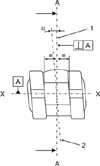1. Creekmore TD, Kunik RL. Straight wire: the next generation. Am J Orthod Dentofacial Orthop. 1993. 104:8–20.

2. Ødegaard J, Segner D. Shear bond strength of metal brackets compared with a new ceramic bracket. Am J Orthod Dentofacial Orthop. 1988. 94:201–206.

3. Feldner JC, Sarkar NK, Sheridan JJ, Lancaster DM. In vitro torque-deformation characteristics of orthodontic polycarbonate brackets. Am J Orthod Dentofacial Orthop. 1994. 106:265–272.

4. Cacciafesta V, Sfondrini MF, Scribante A, Klersy C, Auricchio F. Evaluation of friction of conventional and metal-insert ceramic brackets in various bracket-archwire combinations. Am J Orthod Dentofacial Orthop. 2003. 124:403–409.

5. Kapur Wadhwa R, Kwon HK, Sciote JJ, Close JM. Frictional resistance in ceramic and metal brackets. J Clin Orthod. 2004. 38:35–38.
6. Kim JH, Kwon OW, Choi YY. Discoloration and corrosion resistance of Tin-coated orthodontic appliances produced by Ion-plating method. Korean J Orthod. 1993. 23:327–340.
7. Maijer R, Smith DC. Biodegradation of the orthodontic bracket system. Am J Orthod Dentofacial Orthop. 1986. 90:195–198.

8. Toms AP. The corrosion of orthodontic wire. Eur J Orthod. 1988. 10:87–97.

9. House K, Sernetz F, Dymock D, Sandy JR, Ireland AJ. Corrosion of orthodontic appliances-should we care? Am J Orthod Dentofacial Orthop. 2008. 133:584–592.

10. Park HY, Shearer TR. In vitro release of nickel and chromium from simulated orthodontic appliances. Am J Orthod. 1983. 84:156–159.

11. Lim YK, Yang WS. An experimental study on the cytotoxicity of orthodontic wires. Korean J Orthod. 1996. 26:591–599.
12. Lee GH, Cho JH, Lee KH, Hwang HS. Evaluation of cytotoxicity of electroplated stainless steel orthodontic wire. Korean J Orthod. 2005. 35:127–136.
13. Ceen RF, Gwinnett AJ. Indelible iatrogenic staining of enamel following debonding: a case report. J Clin Orthod. 1980. 14:713–715.
14. Maijer R, Smith DC. Corrosion of orthodontic bracket bases. Am J Orthod. 1982. 81:43–48.

15. Kim MS, Sung JH, Kwon OW. A study on metal release of tin ion-plated stainless steel orthodontic appliances. Korean J Orthod. 1995. 25:43–54.
16. International Organization for Standardization. Dentistry: brackets and tubes for use in orthodontics. ISO 27020. 2010.
17. International Organization for Standardization. Biological evaluation of medical devices. Part 5: Test for in vitro cytotoxicity. ISO 10993-5. 2009.
18. International Organization for Standardization. Dental metallic materials: corrosion test methods. ISO 10271. 2011.
19. Oh KT, Choo SU, Kim KM, Kim KN. A stainless steel bracket for orthodontic application. Eur J Orthod. 2005. 27:237–244.

20. Kao CT, Ding SJ, Min Y, Hsu TC, Chou MY, Huang TH. The cytotoxicity of orthodontic metal bracket immersion media. Eur J Orthod. 2007. 29:198–203.

21. Yoo DH, Kook YA, Kim SC. An experimental study on the cytotoxicity of various orthodontic bands. Korean J Orthod. 1994. 24:419–432.
22. Lim YK, Yang WS. An experimental study on the cytotoxicity of recycled brackets. Korean J Orthod. 1993. 23:147–163.
23. Oh KT, Kim KN. Ion release and cytotoxicity of stainless steel wires. Eur J Orthod. 2005. 27:533–540.

24. Freitas MP, Oshima HM, Menezes LM, Machado DC, Viezzer C. Cytotoxicity of silver solder employed in orthodontics. Angle Orthod. 2009. 79:939–944.

25. Eliades T, Athanasiou AE. In vivo aging of orthodontic alloys: implications for corrosion potential, nickel release, and biocompatibility. Angle Orthod. 2002. 72:222–237.
26. Staerkjaer L, Menné T. Nickel allergy and orthodontic treatment. Eur J Orthod. 1990. 12:284–289.

27. Sfondrini MF, Cacciafesta V, Maffia E, Scribante A, Alberti G, Biesuz R, et al. Nickel release from new conventional stainless steel, recycled, and nickel-free orthodontic brackets: an in vitro study. Am J Orthod Dentofacial Orthop. 2010. 137:809–815.

28. Choi CM, Rhee BT. The effects of heat treatment on mechanical properties and metal release from heat-treated orthodontic archwires. Korean J Orthod. 1990. 20:381–390.
29. Grimsdottir MR, Gjerdet NR, Hensten-Pettersen A. Composition and in vitro corrosion of orthodontic appliances. Am J Orthod Dentofacial Orthop. 1992. 101:525–532.

30. National Research Council. Dietary reference intakes: the essential guide to nutrient requirements. 2006. Washington, DC: The National Academies Press.




 PDF
PDF ePub
ePub Citation
Citation Print
Print

















 XML Download
XML Download